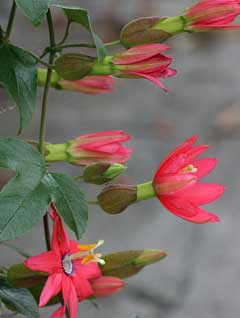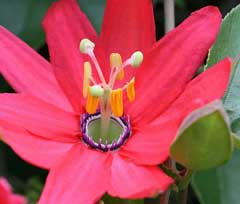 |
|
www.flickr.com/photos/pbouchard |
 |
| www.flickr.com/photos/pbouchard |
Translate this page:
Summary
Physical Characteristics

 Passiflora mollisima is an evergreen Climber growing to 5 m (16ft 5in) at a fast rate.
Passiflora mollisima is an evergreen Climber growing to 5 m (16ft 5in) at a fast rate.
See above for USDA hardiness. It is hardy to UK zone 6 and is not frost tender. It is in leaf all year, in flower from July to September. The species is hermaphrodite (has both male and female organs) and is pollinated by Bees.
Suitable for: light (sandy), medium (loamy) and heavy (clay) soils and prefers well-drained soil. Suitable pH: mildly acid, neutral and basic (mildly alkaline) soils. It cannot grow in the shade. It prefers moist soil.
UK Hardiness Map
US Hardiness Map
Synonyms
Tacsonia mollissima.
Plant Habitats
South Wall. By. West Wall. By.
Edible Uses
Edible Parts: Fruit
Edible Uses:
Fruit - raw or cooked[46, 105]. An agreeable flavour[2]. An aromatic taste, it can be eaten out of hand or used as a flavouring in ice creams, fruit salads, puddings etc[183]. A juice made from the fruit is highly prized in S. America[183]. Individual fruits are up to 15cm long and weigh 50 - 150g[196].
References More on Edible Uses
Medicinal Uses
Plants For A Future can not take any responsibility for any adverse effects from the use of plants. Always seek advice from a professional before using a plant medicinally.
None known
References More on Medicinal Uses
The Bookshop: Edible Plant Books
Our Latest books on Perennial Plants For Food Forests and Permaculture Gardens in paperback or digital formats.

Edible Tropical Plants
Food Forest Plants for Hotter Conditions: 250+ Plants For Tropical Food Forests & Permaculture Gardens.
More

Edible Temperate Plants
Plants for Your Food Forest: 500 Plants for Temperate Food Forests & Permaculture Gardens.
More

More Books
PFAF have eight books available in paperback and digital formats. Browse the shop for more information.
Shop Now
Other Uses
References More on Other Uses
Cultivation details
Requires a well-drained soil with plenty of moisture in the growing season, otherwise it is not fussy[1]. One report says that this plant is hardy to climatic zone 6 (tolerating frosts of -20°c)[200] but this is surely a misprint. The top growth is said to tolerate slight air frosts[88] and plants are said to be hardy on a wall in the mild areas of Britain, being commonly grown around Penzance[49, 59]. In S. America plants can tolerate occasional lows to -5°c[196]. Outdoor grown plants should have their roots restricted in order to reduce vegetative growth and encourage fruiting[1]. Plants do not generally fruit well in Britain[88]. In order to improve the chances of producing fruit it is best to hand pollinate using pollen from a flower that has been open for 12 hours to pollinate a newly opened flower before midday[88]. Cultivated for its edible fruit in S. America[46, 196]. Yields of 300 fruits per vine and 30 tonnes per hectare are recorded in S. America[196]. A climbing plant, attaching itself to other plants by means of tendrils that are produced at the leaf axils. Plants in this genus are notably resistant to honey fungus[200].
References Carbon Farming Information and Carbon Sequestration Information
Temperature Converter
Type a value in the Celsius field to convert the value to Fahrenheit:
Fahrenheit:
The PFAF Bookshop
Plants For A Future have a number of books available in paperback and digital form. Book titles include Edible Plants, Edible Perennials, Edible Trees,Edible Shrubs, Woodland Gardening, and Temperate Food Forest Plants. Our new book is Food Forest Plants For Hotter Conditions (Tropical and Sub-Tropical).
Shop Now
Plant Propagation
Pre-soak the seed for 12 hours in warm water and then sow late winter or early spring in a warm greenhouse. If sown in January and grown on fast it can flower and fruit in its first year[88]. The seed germinates in 1 - 12 months at 20°c. Prick out the seedlings into individual pots when they are large enough to handle. It you are intending to grow the plants outdoors, it is probably best to keep them in the greenhouse for their first winter and plant them out into their permanent positions in late spring or early summer, after the last expected frosts. Mulch the roots well in late autumn to protect them from the cold. Cuttings of young shoots, 15cm with a heel, in spring[1]. Leaf bud cuttings in spring. Cuttings of fully mature wood in early summer. Takes 3 months. High percentage[3].
Other Names
If available other names are mentioned here
Native Range
Coming Soon
Weed Potential
Right plant wrong place. We are currently updating this section.
Please note that a plant may be invasive in one area but may not in your area so it's worth checking.
Conservation Status
IUCN Red List of Threatened Plants Status :

| Related Plants
|
| Latin Name | Common Name | Habit | Height | Hardiness | Growth | Soil | Shade | Moisture | Edible | Medicinal | Other |
| Passiflora actinia | Passion Flower | Climber | 10.0 |
8-11
| F | LMH | N | M | 3 | 0 | 1 |
| Passiflora antioquiensis | Banana Passionfruit | Climber | 5.0 |
10-12
| F | LMH | SN | M | 4 | 0 | 0 |
| Passiflora caerulea | Passion Flower, Bluecrown passionflower, Blue Passion Flower | Climber | 10.0 |
9-11
| F | LMH | N | M | 3 | 0 | 1 |
| Passiflora edulis | Passion Flower, Purple granadilla | Climber | 9.0 |
9-12
| F | LMH | N | M | 4 | 1 | 1 |
| Passiflora herbertiana | | Climber | 9.0 |
-
| | LMH | SN | M | 2 | 0 | |
| Passiflora incarnata | Maypops - Passion Flower, Purple passionflower, Apricot Vine, Maypop, Wild Passion Flower, Purple Pa | Climber | 6.0 |
7-11
| F | LMH | N | M | 3 | 3 | 0 |
| Passiflora laurifolia | Yellow Granadilla | Climber | 15.0 |
10-12
| F | MH | SN | M | 4 | 2 | 2 |
| Passiflora ligularis | Sweet Grenadilla, Passion Flower | Climber | 5.0 |
9-12
| F | MH | SN | M | 5 | 0 | 2 |
| Passiflora membranacea | Passion Flower | Climber | 5.0 |
8-11
| F | LMH | N | M | 3 | 0 | |
| Passiflora popenovii | Granadilla de Quijos | Climber | 8.0 |
10-12
| F | MH | SN | M | 4 | 0 | 0 |
| Passiflora quadrangularis | Giant Granadilla, Badea | Climber | 15.0 |
10-12
| F | MH | SN | M | 4 | 2 | 0 |
| Passiflora species | Passion Flower | Climber | 5.0 |
-
| F | LMH | N | M | 3 | 0 | |
| Passiflora tarminiana | banana passionfruit, banana poka | Climber | 10.0 |
10-12
| F | MH | SN | M | 4 | 0 | 0 |
| Passiflora tetrandra | | Climber | 9.0 |
-
| | LMH | SN | M | 1 | 0 | 2 |
| Passiflora tripartita mollissima | Banana Passionfruit | Climber | 5.0 |
10-12
| F | MH | SN | M | 4 | 0 | 0 |
| Passiflora umbilicata | Passion Flower | Climber | 5.0 |
8-11
| F | LMH | N | M | 2 | 0 | |
| Passiflora x colvillii | Passion Flower | Climber | 10.0 |
6-9
| F | LMH | N | M | 2 | 0 | |
| Passiflora x exoniensis | Passion Flower | Climber | 5.0 |
9-11
| F | LMH | N | M | 3 | 0 | |
|
Growth: S = slow M = medium F = fast. Soil: L = light (sandy) M = medium H = heavy (clay). pH: A = acid N = neutral B = basic (alkaline). Shade: F = full shade S = semi-shade N = no shade. Moisture: D = dry M = Moist We = wet Wa = water.
Now available:
Food Forest Plants for Mediterranean Conditions
350+ Perennial Plants For Mediterranean and Drier Food Forests and Permaculture Gardens.
[Paperback and eBook]
This is the third in Plants For A Future's series of plant guides for food forests tailored to
specific climate zones. Following volumes on temperate and tropical ecosystems, this book focuses
on species suited to Mediterranean conditions—regions with hot, dry summers and cool, wet winters,
often facing the added challenge of climate change.
Read More
Expert comment
Author
(Kunth.)L.H.Bailey.
Botanical References
200
Links / References
For a list of references used on this page please go here
Readers comment